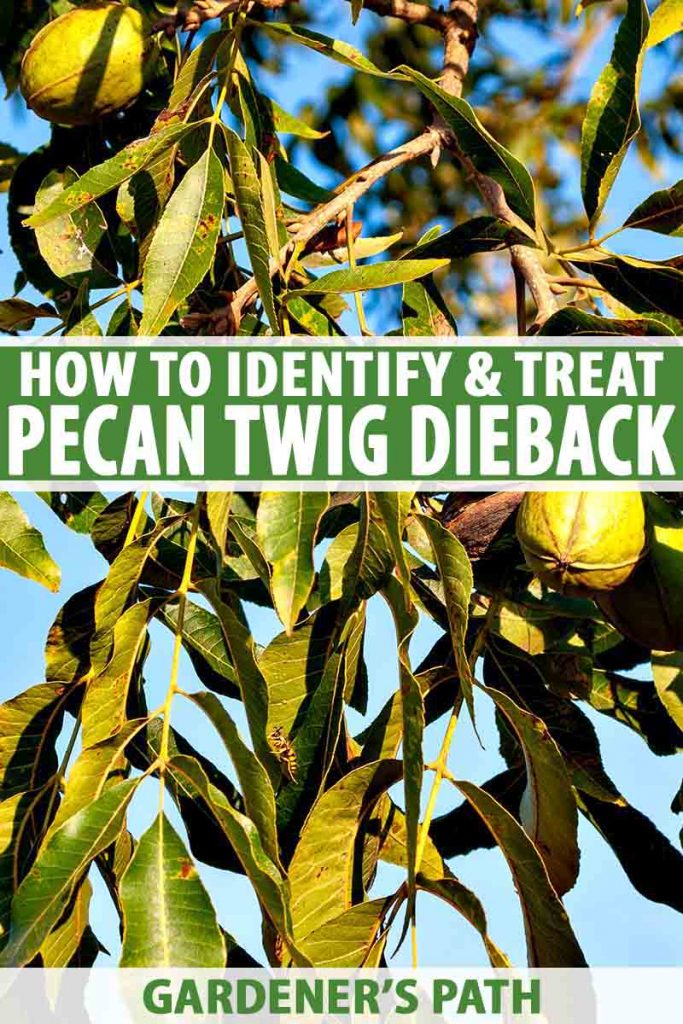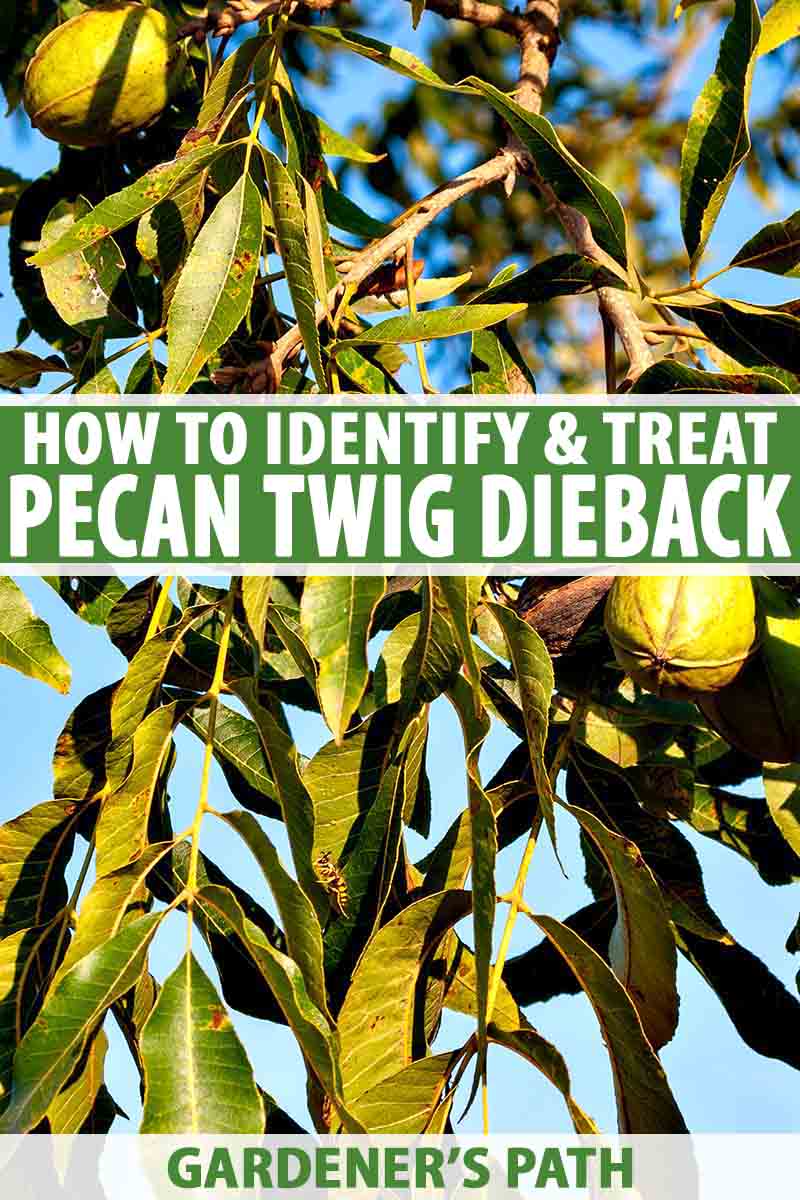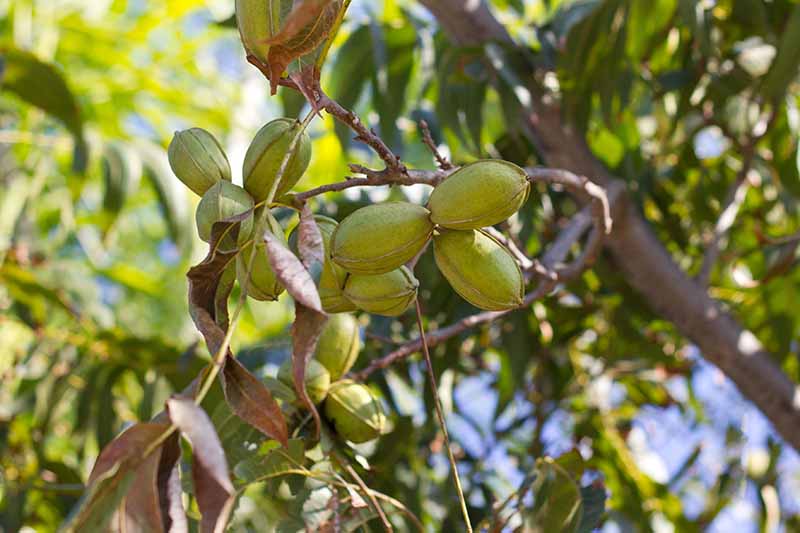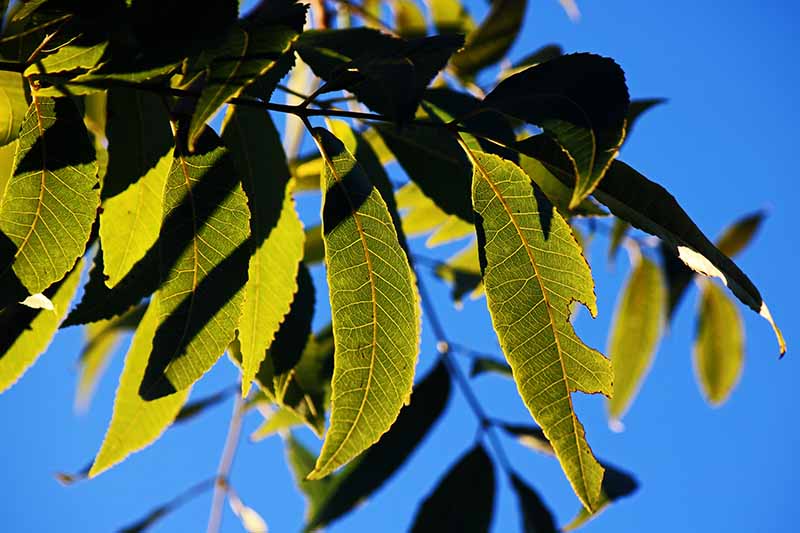Stress can cause infection by the fungi Botryosphaeria spp. on more than 70 different types of trees and shrubs. One particular species, B. ribis, is responsible for stem end blight, a very difficult to manage disease that occurs during nut development. Unfortunately, pecan trees, Carya illinoensis, are amongst those that can suffer from this infection. As its name suggests, this disease can result in the branches dying back. We link to vendors to help you find relevant products. If you buy from one of our links, we may earn a commission. Read on to learn more about this disease and steps you can take to combat it.
Symptoms
Your first sign of pecan twig dieback will be the wilting of some of the branches. If you look more closely, you will find small, raised pustules with black centers – these are known as “cankers.” Other parts of the tree may appear perfectly healthy. If you discover these raised pustules and cut them open, they will be white inside in the case of an infection caused by Botryosphaeria. These pustules are the structures of the fungus that produce spores, which can then spread to healthy tissue. Unless you inspect your trees very closely, you probably won’t even notice these cankers on the branches until they have started wilting and dying back. If you look beneath the bark, you would normally find white tissue. However, those with this infection will have brown or reddish-brown tissue.
Disease Cycle
The fungi overwinter in their fruiting bodies in dead tissue. In the spring, they colonize plant tissue through wounds including those caused by pruning, growth cracks, or insect and other damage. Botyrosphaeria can colonize dead tissue first and then progress into healthy bark and sapwood. It can cause the limbs to die back by as much as 30 inches. Splashing water or wind can also spread the spores, as can dirty pruning tools.
Prune the Infected Tissue
If you discover your tree is suffering from this infection, it is critical to prune the dead wood to keep the disease from moving into healthy wood. Prune branches back to where the tissue is cream-colored or white. Destroy all dead and infected wood. Disinfecting your pruning tools with 70% alcohol between cuts is essential in order to reduce the risk of spreading the infection to healthy tissue as you prune. Depending on how much of your tree is affected, if you are then able to identify the source of the stress and correct it, you will possibly be able to save it.
How to Avoid Twig Dieback
This fungus is what’s known as opportunistic. This means it will only cause disease in pecan trees that have already been compromised by stress. For example, pecan trees can become infected at the graft union of young trees, and where the limbs have been pruned out on older specimens. There is no effective fungicide that you can use to treat this disease. That makes it even more important to make sure that your trees and saplings are always in prime condition.
Carefully Select Your Pecan
Starting with a healthy sapling will go a long way towards preventing this type of infection.
If you are selecting new trees for planting, avoid those that are clearly stressed, such specimens that are severely pot bound. Also avoid any trees with wounds in the branches or trunk, or leaves that are wilted or brown. Make sure you choose a cultivar that will be hardy, and is known to thrive in your area.
Planting Your New Pecan
A nut tree is a long term investment, and once you have made your selections and brought your sapling or young tree home, a little extra TLC can help it on its way towards a healthy and productive life. Keep these tips in mind:
Make sure the pH of the soil where you plan to plant is appropriate for pecan growth. Conduct a soil test if you are unsure, and make appropriate amendments if needed.
Don’t plant your new sapling in an area where the soil is compacted by foot traffic or construction.
Work carefully and enlist help if you need it, to make sure you don’t injure the plant while you are transporting or planting it.
Plant it at an appropriate soil depth for the size of the transplant.
Don’t apply excessive amounts of mulch. In particular, make sure that if you do mulch, none of it is touching the trunk.
Proper Irrigation Is Critical
Drought can cause a pecan to become stressed, which in turn makes it more susceptible to this disease. Keep your trees well-irrigated, particularly during flowering and nut formation. Producing a heavy crop of nuts with little available moisture can lead to twig dieback. You should irrigate when appropriate – especially when your pecan is young and not quite fully established. Additionally, you don’t want your tree growing in boggy, waterlogged conditions either, so you need to ensure that the soil is well-draining.
Tending Your Pecan
It is critical not to introduce any wounds that the fungus could colonize, so be extra careful when using equipment like trimmers or lawn mowers around your pecan. Keep a close eye out for critters such as voles or insects that could cause damage to the plant tissue. This type of damage can also be a haven for the fungus. Provide proper nutrition without fertilizing excessively. Have a pH test done before you fertilize. Too much fertilizer can cause it to produce succulent tissue that is more easily colonized by fungi.
Healthy specimens grown in optimal conditions are mostly able to resist becoming infected by the Botryosphaeria fungi. To learn more about growing pecans, see our full guide. Taking good care of your tree includes pruning it properly, since pruning wounds are a major source of infection. Drought-stressed trees with heavy crops of pecans are much more likely to be infected. So proper irrigation is a key factor to keeping them healthy. Have your pecans suffered from twig dieback disease? Did pruning keep the disease in check? Let us know in the comments. And read on to learn more about other pests and diseases that may affect your plants:
How to Manage Root Rot in Fruit, Nut, and Landscape Trees and Shrubs How to Identify and Prevent Apple Cork Spot How to Identify, Prevent, and Treat Collar and Crown Rot in Fruit Trees
© Ask the Experts, LLC. ALL RIGHTS RESERVED. See our TOS for more details. Originally published on January 28, 2020. [lastupdated]. Uncredited photos: Shutterstock. With additional writing and editing by Clare Groom and Allison Sidhu.




